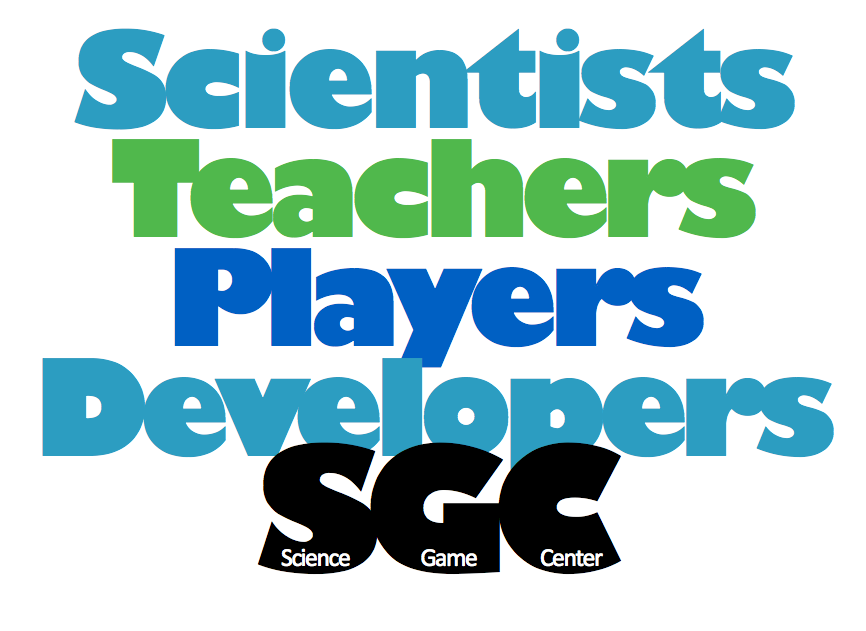Part Two: Integrating the design of a game into your lessons/Using video game design to get your students to interact and learn great amounts from a local scientist.
1. Choose a topic you wish to address. I chose “neurology.” You can choose any topic, video game design works well in English, social studies, and other classes. Choose a length of time to devote to game design. One class period, 4 weeks, or 8 weeks. Have students turn in drafts after 1-2 days. Iteration is very important. So get them iterating quickly.
2. If you are not an expert on the topic you wish to address, find an scientist to participate in this program with you. National Lab Network, for example, is designed to connect teachers with scientists for an extended relationship. Graduate students and post doctoral scientists are qualified to serve as experts for this purpose. The expert should help you choose the core concepts of the topic, and provide an introductory lecture on the core concepts. Let the students speak directly with the scientist as much as possible.
3. The core concepts become the basis of each game. I chose 4 concepts for my neurology lessons: Myelin sheath creation and damage, Neurotransmitter reception and signal integration (whether the neuron fires of not after receding chemical signals from other neurons), Long term change in neurons (gene regulation in response to signals), synapse function such as neurotransmitter re-uptake). The students choose a process and work in small groups or on their own.
4. Schedule the program for 4-8 weeks. Ask the expert to come once a week to discuss the details of the topic with the students. Skype may work, as well as telephone + teamviewer. But each group of students or each student will need 15-30 minutes per week to speak directly with the expert, and will also need to be able to communicate by email. This level of commitment is possible to get from a graduate student, or post doctoral scientist. They are experts in the concepts and principles of their fields and have the capacity to research facts and details on behalf of your students.
5. Students will need to decide what they want to present in their game. They should make a list of principles and concepts they hope to teach their players. They may also choose to make a list of facts and vocabulary to teach. Review this list of concepts, principles, vocabulary and facts for their relevance to the topic, for their overall importance in the field, and for their appropriateness for the target audience/your class. For example, if your 10th grade English students plan to design a game that teaches 4 year olds to read, you may question whether that choice will teach your students the concepts and principles you expect them to learn in your class. A better idea may be to have the 10th graders design a game for 6th graders that helps them identify metaphors and decipher them.
5. Game design documents. Show samples, discuss what they are used for: For the game designer to communicate to the programmer, for the designer to communicate to the funder, for a scientist to communicate with the designer.
6. Iteration. Just like essays, video games require editing. Leave time for it, and also encourage students to keep track of the game ideas in a notebook, and to save their version of the game once a week. 40% of the scheduled time must be left for testing with focus groups (fellow students) and problems will arise in understanding and troubleshooting them is part of the learning process for the game designers.
7. Paper prototypes and focus group testing. Game design does not require computer programming. Games are usually tested with a paper prototype anyway. Many types of paper prototypes are used. Additionally, PowerPoint presentations can be used to create a series of “screenshots” to describe the game.
8. Discuss whether a different design would have presented the same ideas, whether the game misrepresents anything, how technology development is a team process, and how the final project varied from the original designs.
******************
End of the Paper Design version of Video Game Design. The STEM Video Game Challenge has a Paper Design entry class, see their requirements here: http://www.stemchallenge.org/about/Default.aspx?Cat=MS
******************
9. Programming. Games can be programmed in many different programs with varying levels of programming skills required. Game Maker, Small Basic, Unity3d, Kodu, Scratch, Game Salad, Atmosphir are a few inexpensive programming engines. GameStar Mechanic is a commercial product that makes simple 2d games, but that does not require programming.
10. Iteration increases engagement of target audience as well as the quality of teaching.
11. Assessing learning. Your students should create a 10 question survey based on the concepts they expected to convey as they began designing their game. They can design an evaluation of learning, using principles of good experimental design: controlled samples, an unbiased analysis, statistical analysis, etc.
12. Discuss whether a different design would have presented the same ideas, whether the game misrepresents anything, how technology development is a team process, and how the final project varied from the original designs.

